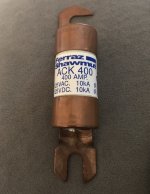peadar
100 W
I will keep an eye open ,thanksHaven’t used the BMS yet. I haven’t finish the battery build.
I will keep an eye open ,thanksHaven’t used the BMS yet. I haven’t finish the battery build.
Funny, @Dui ni shuo de dui and I just argued the pros and cons of that in a different thread.So it’s been a while since I’ve updated this thread. I’m still working on the battery and and will post more pictures once I get finished.
So I have a question as far as using a fuse or not. Since I’m using a BMS with overcurrent protection would I still need to use a fuse? I’m leaning toward not using one unless you all think it would be unsafe. The BMS will NOT be bypassed so I would think that would be enough protection, but please correct me if I’m wrong?!?
Yes a fuse is absolutely necessary.So it’s been a while since I’ve updated this thread. I’m still working on the battery and and will post more pictures once I get finished.
So I have a question as far as using a fuse or not. Since I’m using a BMS with overcurrent protection would I still need to use a fuse? I’m leaning toward not using one unless you all think it would be unsafe. The BMS will NOT be bypassed so I would think that would be enough protection, but please correct me if I’m wrong?!?
Funny, @Dui ni shuo de dui and I just argued the pros and cons of that in a different thread.
Personally, I'd always use a fuse on the actual battery output, as close to the casing as possible (inside right at the cell block output is better but less accessible for repair), just because there are situations in which a wiring fault (crash, etc) could short circuit the battery itself, and if the BMS FETs failed stuck on for any reason (which you won't know until it tries to turn them off and can't), it couldn't do anything about such a short, and you could end up with a fire in the wiring even if it doesn't hurt the cells, etc.
The fuse can be much higher current than you will ever actually use in the system, as long as it's rated for the system voltage *in DC Volts* (not just AC) to be guaranteed to break the circuit. (it *might* still break the circuit if it's not rated for it, but it isn't guaranteed, and if it's only AC rated it is sized to expect zero voltage many times a second where it may break an arc).
There are several times over the decades I have not had a fuse in some power supply (battery, PSU, etc) output and some wiring fault or miswire occured that nearly instantly began smoking the wiring insulation, or actually setting it on fire. Once there was a breaker but it was really installed as a switch, and it did pop, but not until after the whole wiring harness that included the wires that shorted was melted into a single mass of plastic and metal.
None of these was a really high current source, or high voltage, they were all less than 24v, most were "12v" (13-14v actual) systems. I don't really like to imagine the heat and fire potential if they'd been something like my EIG traction packs.
There are certain battery configurations where fuses *between sections* might even be desirable, to avoid "plasmaboy" scenarios. Electric Vehicle Discussion List - How Plasma Boy Got His Name
Disadvantages to a fuse are more interconnects so more possible failure points, a very slight voltage drop across the fuse under load, etc.
Yes a fuse is absolutely necessary.
You cannot rely on anything else. If something goes very wrong there WILL be a fuse somewhere no matter what. Either it will be your controller, your BMS, your power wiring or, worse, your battery, but something will burn for sure in case of short circuit.
The BMS can go wrong and if it goes wrong it is possible that it fails closed, which would allow current to pass.
You want the stuff to burn to be something that has been designed for it and that you know will burn without damaging surrounding stuff. This is really something that cannot be skipped in a safe build, in my opinion.
If it is to be integrated inside the battery, make sure that the cells that are close to it are protected physically from damage for when the fuse will burn. If it's not convenient to put it inside the battery then you can also move it outside of the battery on the power wires, but the closer to the battery the better (in case there's a short on the main power lines).

I think it does, but not 100% sure.Does your BMS have a UART port on the side like this image below
